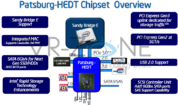- Joined
- Oct 9, 2007
- Messages
- 47,852 (7.39/day)
- Location
- Dublin, Ireland
| System Name | RBMK-1000 |
|---|---|
| Processor | AMD Ryzen 7 5700G |
| Motherboard | Gigabyte B550 AORUS Elite V2 |
| Cooling | DeepCool Gammax L240 V2 |
| Memory | 2x 16GB DDR4-3200 |
| Video Card(s) | Galax RTX 4070 Ti EX |
| Storage | Samsung 990 1TB |
| Display(s) | BenQ 1440p 60 Hz 27-inch |
| Case | Corsair Carbide 100R |
| Audio Device(s) | ASUS SupremeFX S1220A |
| Power Supply | Cooler Master MWE Gold 650W |
| Mouse | ASUS ROG Strix Impact |
| Keyboard | Gamdias Hermes E2 |
| Software | Windows 11 Pro |
At Computex 2010, motherboard vendors across the board displayed socket LGA1155 motherboards that support Intel "Sandy Bridge" processors, based on P67, H67 chipsets, months in advance of the platform actually making it to the market. This year, the motherboard industry will do something similar and show off socket LGA2011 motherboards based on the Intel X79 "Patsburg" chipset.
Detailed to much length in older articles, the platform schematic of Sandy Bridge-E surfaced, confirming X79's feature-set, including a PCI-Express 3.0 based supplementary interconnect between the processor and chipset to bolster enough bandwidth for the massive 10-port SATA 6 Gb/s controller, and a 8-port PCI-Express 2.0 hub. Sandy Bridge-E processor itself comes in three main variants, an all-enabled 6-core Extreme Edition, a 6-core unlocked variant, and a limited-OC 4-core variant. The platform is slated for late 2011.

View at TechPowerUp Main Site
Detailed to much length in older articles, the platform schematic of Sandy Bridge-E surfaced, confirming X79's feature-set, including a PCI-Express 3.0 based supplementary interconnect between the processor and chipset to bolster enough bandwidth for the massive 10-port SATA 6 Gb/s controller, and a 8-port PCI-Express 2.0 hub. Sandy Bridge-E processor itself comes in three main variants, an all-enabled 6-core Extreme Edition, a 6-core unlocked variant, and a limited-OC 4-core variant. The platform is slated for late 2011.

View at TechPowerUp Main Site





 The point of having USB 3.0 in the SB/PCH/NB/etc. is to "officially" make it a mainstream connector. Purely symbolic, but the gesture is reassuring.
The point of having USB 3.0 in the SB/PCH/NB/etc. is to "officially" make it a mainstream connector. Purely symbolic, but the gesture is reassuring.
